Everest base camp trek. Guaranteed departure dates
A very popular trekking destination for its bizarre variations, difficulties and adventurous approach along with the loyal and friendly Sherpa inhabitants, Everest Base Camp Trek has been one of the most famous trekking destinations since the very first expedition to Everest Summit in 1953 by Sir Edmond Hilary and Tenzing Norgey. See also >>>
A very popular trekking destination for its bizarre variations, difficulties and adventurous approach along with the loyal and friendly Sherpa inhabitants, Everest Base Camp Trek has been one of the most famous trekking destinations since the very first expedition to Everest Summit in 1953 by Sir Edmond Hilary and Tenzing Norgey. See also >>>
Everest Easy Trek
Everest Easy Trek is one of the shortest treks in Everest region. It is not so difficult trekking as other and especially for those who have a dream to see the top of the world and have less time or too old or who cannot walk much distance. Everest Easy Trek is available for all season but we recommend to visit at the best time that is from March to May and September to November. See also another itinerary of same duration.
Everest Easy Trek is one of the shortest treks in Everest region. It is not so difficult trekking as other and especially for those who have a dream to see the top of the world and have less time or too old or who cannot walk much distance. Everest Easy Trek is available for all season but we recommend to visit at the best time that is from March to May and September to November. See also another itinerary of same duration.
Island Peak (6189 m) expedition
Climbing island peak is very easy so the climbers from the different parts of the world are interested to attempt it. Mt. Everest, Mt Makalu, Mt. Lhotse and many other mountains are visible in the route. Fixed Dates - October 4, 25 - November 12; March - 11; April 25; May 6, 12, 18. See also >>>
Climbing island peak is very easy so the climbers from the different parts of the world are interested to attempt it. Mt. Everest, Mt Makalu, Mt. Lhotse and many other mountains are visible in the route. Fixed Dates - October 4, 25 - November 12; March - 11; April 25; May 6, 12, 18. See also >>>
Cho-Oyu Expedition (8201m)-43 Days
Cho-Oyu is sixth highest mountain in the world. It is about 8,201m (26906 ft) above sea level. Cho Oyu means "Turquoise Goddess" in Tibetan. Cho Oyu is considered the easiest 8,000m peak to climb. Full board & (or) Base Camp Service optional. Dates: 8.04 & 4.09 See also >>>
Cho-Oyu is sixth highest mountain in the world. It is about 8,201m (26906 ft) above sea level. Cho Oyu means "Turquoise Goddess" in Tibetan. Cho Oyu is considered the easiest 8,000m peak to climb. Full board & (or) Base Camp Service optional. Dates: 8.04 & 4.09 See also >>>







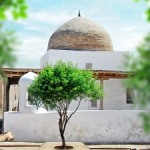 Ak Mosque (1838-1842) - (Ichan-Kala)
Ak Mosque (1838-1842) - (Ichan-Kala)  Ibrahim Khodja Madrasah (1888) - (Khiva District)
Ibrahim Khodja Madrasah (1888) - (Khiva District) 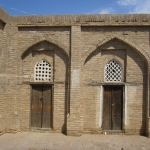 Atajanbay Madrasah (1884) - (Ichan-Kala)
Atajanbay Madrasah (1884) - (Ichan-Kala)  The walls of Dishan-Kala (1842) - (Dishan-Kala)
The walls of Dishan-Kala (1842) - (Dishan-Kala) 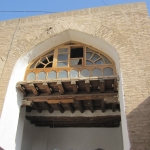 Abdurasulbay Madrasah (1906) - (Ichan-Kala)
Abdurasulbay Madrasah (1906) - (Ichan-Kala)  Sayid Niyaz Shalikarbai Mosque and Madrasah - (Dishan-Kala)
Sayid Niyaz Shalikarbai Mosque and Madrasah - (Dishan-Kala)  Bibi Hojar Mausoleum (1846) - (Khiva District)
Bibi Hojar Mausoleum (1846) - (Khiva District) 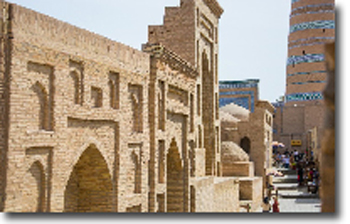 Hojashberdibiya Madrasah (1688-1834) - (Ichan-Kala)
Hojashberdibiya Madrasah (1688-1834) - (Ichan-Kala)  Matrasulboy Mirzaboshi Madrasah (1905) - (Ichan-Kala)
Matrasulboy Mirzaboshi Madrasah (1905) - (Ichan-Kala)  Mazari Sharif Madrasah (1882) - (Ichan-Kala)
Mazari Sharif Madrasah (1882) - (Ichan-Kala)  Kazy Kalyan Madrasah (1905) - (Ichan-Kala)
Kazy Kalyan Madrasah (1905) - (Ichan-Kala) 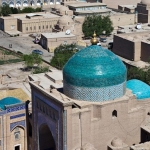 Chilli Avliya Minaret (19th century) - (Dishan-Kala)
Chilli Avliya Minaret (19th century) - (Dishan-Kala)  Islam Khodja Minaret (1910) - (Ichan-Kala)
Islam Khodja Minaret (1910) - (Ichan-Kala)  Kosh-Darvaza (1912) - (Dishan-Kala)
Kosh-Darvaza (1912) - (Dishan-Kala)  Sayyid Muhammad Makhiruy Mausoleum (19th century) - (Dishan-Kala)
Sayyid Muhammad Makhiruy Mausoleum (19th century) - (Dishan-Kala) 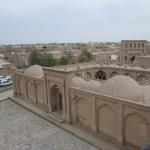 Dost Alyam Madrasah (1882) - (Ichan-Kala)
Dost Alyam Madrasah (1882) - (Ichan-Kala)  Muhammad Maram Minaret (1903) - (Dishan-Kala)
Muhammad Maram Minaret (1903) - (Dishan-Kala)  Khorezmshakh Madrasah (1915) - (Dishan-Kala)
Khorezmshakh Madrasah (1915) - (Dishan-Kala)  Amir Tura Madrasah (1870) - (Ichan-Kala)
Amir Tura Madrasah (1870) - (Ichan-Kala)  Shergazi Khan Madrasah (1718 to 1726) - (Ichan-Kala)
Shergazi Khan Madrasah (1718 to 1726) - (Ichan-Kala) 